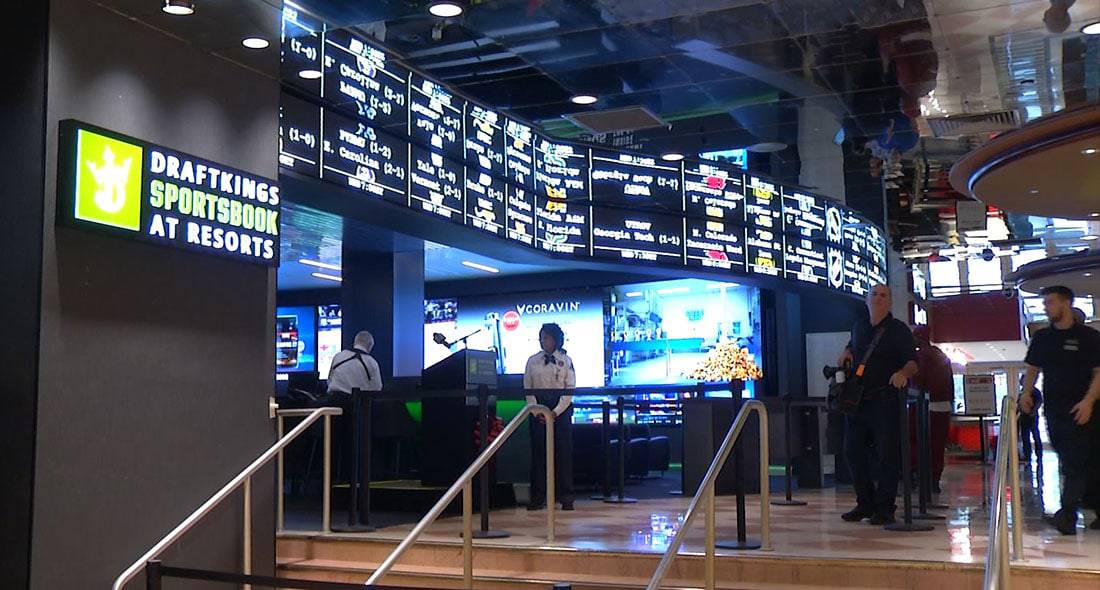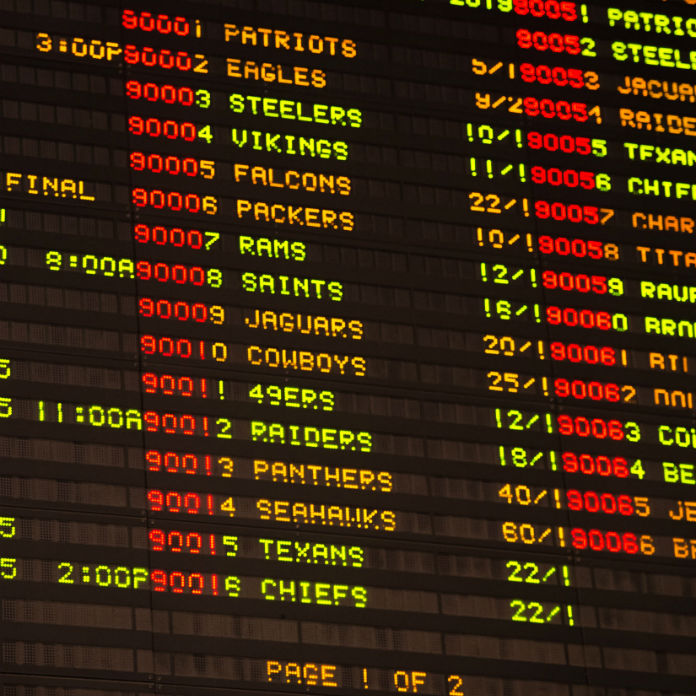How Sports Betting Odds Work
- How Do Vegas Sports Betting Odds Work
- How Does Sports Betting Odds Work
- How Do Sports Odds Work
- How To Read Vegas Lines

How do the sports betting odds work for this game? The Giants are -1.5, which means that the Giants are favored by 1.5 points over the Cardinals. If you bet the Giants at -1.5, you would need New York to win. Defining plus and minus, one of the most common gambling phrases. What does 'plus' and 'minus' mean as a sports betting term? Odds expressed in terms of money, with $100 being the standard.
- Each sports betting event will have a certain outcome – in the end, there will be a winner and a second-placed team (may vary depending on the sport). However, since all sports are a game of skill.
- As explained betting odds indicate the probability and the chances of an outcome whether come in a fractional, or decimal, or as American odds. Also, sportsbook odds show us the possible winning.
Sports betting has become a phenomenon across the world. People all around the world will put wagers on a sporting event to create more excitement around a game for themselves. Let’s face it, you wouldn’t watch a 1-10 team play a 2-9 team without placing a wager. But once the wager is in, you’re absolutely tuning in and watching every second.
Betting lines are used for sportsbooks to put a price on a certain wager. If you’re looking at a team with -150 odds to win, they’re a favorite. If it pays out, you will receive less than you put in. However, if you bet on the opposite side and take a chance with a +150 underdog, you would make more profit if the team won. Read more about Moneyline betting here.
Who creates the betting lines that are used by sportsbooks?
How Do Vegas Sports Betting Odds Work
Most sportsbooks have in-house oddsmakers that are in charge of creating betting lines in the weeks before games, especially when it comes to Opening Day or the NFL. In baseball, the oddsmakers are required to make the lines daily as games never seem to stop in the summer with the MLB.
Years ago, the oddsmakers didn't have that much information to look at when trying to make betting lines. Now there are analytics everywhere to come up with all of the lines much more accurately.
Back then, oddsmakers would really only have box scores to look at. Now oddsmakers can look up anything and everything which gives them an advantage over the average bettor. Of course, records and things like the weather are important, but deeper stats mean so much more to oddsmakers. They’re able to develop systems to figure out exactly how much a team will score and such. You know the saying, “Vegas is always right.” Unless you follow Doc’s Sports picks. Then it’s different.
How Lines Move
When a game starts out at -3 for a team and the line changes to -2 before the game begins, that means that there’s action on the game or an injury to a key player. There are 'sharp' bettors that place a large bet on one team that forces oddsmakers to raise an eyebrow and switch the lines. An oddsmaker is always watching action to see if a change is necessary on the lines.
Popular Ways to Bet
Point spread
A point spread is a handicap where you essentially give or receive points on top of the actual outcome of the game. The spread basically looks at how a sportsbook or oddsmaker thinks about what the outcome might be. For example, in an NFL game, if the Kansas City Chiefs are -3 on the spread, the oddsmakers believe that the Chiefs will win their game by three points. If your data and analysis say otherwise, you would be on the opposite slide and gain three points from their opponent. So, if you bet on the Chiefs with the spread, you would have needed them to win by more than 3 points to cash your ticket. If the score was 27-21, Chiefs, you would win your bet. But if it was 23-21, Chiefs, you would lose because the other side gained three points and won 24-23 theoretically. Betting on spreads allows you to pick a team to win with better odds. If you were to just pick the Chiefs to win that game, you would have to lay a lot of money on the Chiefs. Picking them against the spread gives you a chance to make money near an even line.
Moneyline bets:
Moneyline bets take some stress away. With a moneyline bet, you only need your team to win the game and don’t need to worry about how much they do it by. We’ve all been there where we’ve taken a team to win by 7.5 and then a team wins by just seven. Those are the worst bad breaks and losing bets possible and not fun to endure. After the game, you’ll then wish you had been on the moneyline instead. Those absolutely sting.
The problem with money lines is that you will have to lay a lot more money on the team to win. On heavy favorites, you’re looking at putting down $300 just to win $100 on teams that are -300 American odds. If the San Francisco 49ers were -300 against the Minnesota Vikings, all you would need is for the 49ers to win the game. However, if they are upset, you’d lose $300 trying to win just $100. Heavy money lines are very scary if your team doesn’t perform like they should be or how they were projected to.
Point total bets
With totals, or over/under betting, you don’t need to worry about who wins the game. You’re worried about how many points are scored in the game. For example, if you bet over 52 points on the New York Giants against the Philadelphia Eagles, you’d want the combined score between the two teams to be more than 52 points. Therefore, if the score was 35-28, you would have 63 points and score over 52 points. If the score was 17-14, you would have a total of 31 points and the total would go under. Therefore, you would lose the wager and the bet.
You don’t only have to bet on the total for the game, but you can also bet on the team total for a certain team. If you’re not sure about one side but you love the other side, you can isolate a team and bet their team total.
Proposition bets:
Many people make their money on proposition bets. Prop bets are available for most sporting events, and you can bet anything from a team’s total to how many yards a player will rush for to how many touchdowns a player will score. Prop bets are like playing fantasy sports but with odds.
Prop bets are extremely popular during the Super Bowl, where people go as far as betting on how long the National Anthem will be. There are some ridiculous props like what color Gatorade will be poured on the winning head coach. Unless you have insight on those bets, it’s hard to have concrete analysis for that. You’re basically just trying to hit the lottery.
Doc’s Sports is offering $60 worth of member’s picks absolutely free – no obligation, no sales people – you don’t even have to enter credit card information. You can use this $60 credit any way you please for any handicapper and any sport on Doc’s Sports list of expert sports handicappers. Get $60 worth of premium members’ picks free.
Sports odds work by offering gamblers the chance to profit if they can correctly guess the outcome of a sports event or predict something that happens in sports. The odds represent the financial contract between the gambler and the bookmaker. The three main ways that sports odds are displayed are known as American odds, fractional odds and decimal odds. These three types of odds look different but represent the same thing: the payout for a winning bet in relation to the amount of money that was bet. Point spreads and over-under bets are other types of sports odds.
Casinos and sportsbooks profit when they have to pay out less than they receive in bets. They also collect a commission — sometimes called the 'juice' — on certain bet to increase their chances of making a profit. Sports odds typically are set so that the bookmaker can expect equal betting on each side of the bet, which would ensure that the bookmaker would not lose money, no matter what happens in the sports event. If the bookmaker collected juice on each bet, the bookmaker would be guaranteed to profit if the betting on each side was equal.

American Odds
One common way for bookmakers in the United States to display sports odds is to show either a plus sign (+) or minus sign (-) followed by a number. Odds with a minus sign represents how much money must be bet on a favorite — the team or competitor that is expected to win — in order to win $100 US Dollars (USD), and odds with a plus sign show how much money would be won if $100 USD was bet on an underdog — a team or competitor that is not expected to win. For example, the odds for betting on a favorite might be displayed as -120, which means that a gambler must bet $120 USD to win $100 USD. The odds for betting on an underdog might be displayed as +115, which means that for a winning bet of $100 USD, the gambler would make $115 USD. In a sports event that has one favorite and one underdog, such as a football game, the number listed in the odds for the favorite is higher than the number in the underdog's odds, which increases the bookmaker's chances of making a profit.

Gamblers should be aware that when American odds are used, the total payout for a winning bet is $100 USD more than the number displayed. For example, if a man bet $120 USD on a favorite with -120 odds and won the bet, he would receive a total of $220 USD back from the bookmaker — his original $120 USD bet plus the $100 USD that he won. Likewise, if he won a $100 USD bet on an underdog with +115 odds, he would receive a total of $215 USD back — his $100 USD bet plus the $115 USD he won.
It is not always necessary to bet exactly the amount shown. A gambler might choose to bet much more than $100 USD or want to win more than $100 USD. For example, a woman could bet $3,000 USD on an underdog with +130 odds, and if she won the bet, she would get back a total of $6,900 USD — her original $3,000 USD bet plus $3,900 USD, which is $130 USD for each $100 USD of her bet.
How Does Sports Betting Odds Work
Fractional Odds
In the United Kingdom and in horse racing everywhere, odds typically are displayed in fractions, such as 8/5, 3/1 or 10/1. When spoken, these odds are read like ratios, such as 'eight to five,' 'three to one' or 'ten to one.' The first number is the amount of money that can be won on a bet in the amount of the second number. For example, if a gambler won a bet at 3/1 odds, he or she would win $3 USD for every $1 USD that was bet. Like American odds, the payout number does not include the amount of the original bet, which also is returned to the gambler. So a man who won a $250 USD bet at 3/1 odds would receive $1,000 USD back from the bookmaker — his original $250 USD bet plus his $750 USD winnings.
Decimal Odds
Unlike American odds and fractional odds, decimal odds show the gambler exactly what the payout will be based on the amount of the bet — the return of the original bet amount is built into the number. As the name implies, decimal odds are expressed in decimals, such as 1.50, 2.50 or 4.25. In these three examples, a winning bet of $200 USD would result in a total payout of $300 USD, $500 USD or $850 USD, which are simply the amount multiplied by the decimal shown in the odds. Decimal odds must be higher than 1.00, or even a winning bet would result in the gambler losing money. This method of displaying sports odds is popular in Canada, continental Europe and Australia.
Point Spreads
For a sports event in which a score is kept, gamblers can bet on who will win as well as the margin of victory. Betting on who will win is referred to as a straight-up bet or betting on the moneyline, and betting on the margin of victory is referred to as a point-spread bet. Point spreads are expressed in numbers preceded by minus signs for favorites and plus signs for underdogs, such as -7.5 for a favorite in an American football game and +7.5 for the underdog in the same game.

A bet on a favorite is won when the favorite wins the game by more than the point spread, and a bet on the underdog is won when the underdog wins the game or loses by less than the point spread. For example, if a gambler bet on a team at a point spread of +8 and the team lost by only six points, the gambler would win the bet. On the other hand, if a gambler bet on a team at a point spread of -6 and the team won by only one point, the gambler would lose the bet. Bookmakers typically set the point spread based on both the expected result of the game and what odds will bring in equal betting on both sides.
How Do Sports Odds Work
Point spreads are sometimes listed with odds for the bet, such as -7(-110), -7(11/10) or -7(2.10). All of these odds represent the same bet — a team favored by seven points, with winnings of $11 USD for every $10 USD that is bet. If no odds are displayed with the point spread, it typically is implied that the odds are -110, 11/10 or 2.10.
Over-Under
Another common way to bet on sports event in which a score is kept is the over-under bet, also called betting on the total. In this type of bet, the gambler is betting on the total points scored in the game, regardless of how many points each team scores or which team wins. For example, if the over-under for a basketball game is 180, a gambler could bet the 'over' and win if more than 180 total points are scored or could bet the 'under' and win if fewer than 180 total points are scored. Just like point spreads, over-under bets typically are implied at -110, 11/10 or 2.10 odds unless otherwise specified.
Other Types of Bets
How To Read Vegas Lines
There are seemingly endless other ways for gamblers to bet on sports. Just a few examples are future bets, in which the bet depends on a result that will take place much later, such as a betting before the season on which team will win the championship; parlays, in which gamblers bet on multiple things and must win all of the bets to receive the payout, usually at very high odds; and proposition bets, in which gamblers bet on very specific results, such as the points scored by a single player or the number of times a certain thing happens in a game. There also are over-under bets that involve things other than the total points scored, such as the combined number of free throws for both teams in a basketball game or the combined number of passing yards for both teams in an American football game.